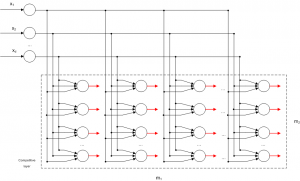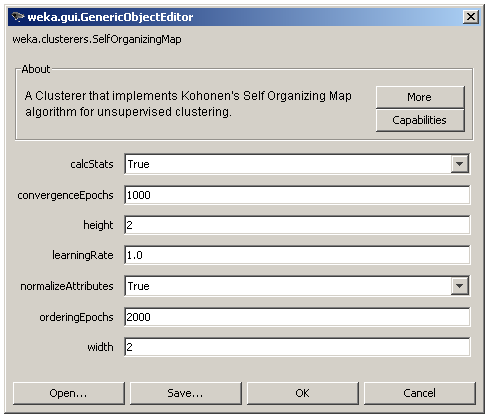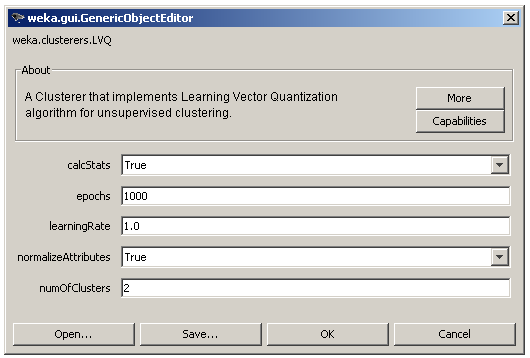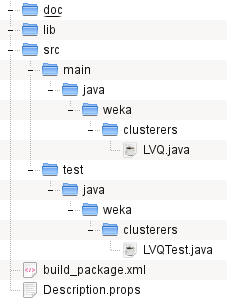Foreword
In a previous article, we shown that by using WEKA a researcher can easily implement her own algorithms without other technical concernings like binding an algorithm with a GUI or even loading the data from a file/database, as these tasks and many others are handled transparently by the WEKA framework. [1]
In this article we will study Competitive Learning Networks and more especially the Learning Vector Quantization and Self-Organizing Maps architectures. Finally we will describe the implementation of these networks for WEKA. [2]
1. Competitive Learning Networks
Competitive Learning is usually implemented with Neural Networks that contain a hidden layer which is commonly called as “competitive layer” (see Figure 1). Every competitive neuron is described by a vector of weights
and calculates the similarity measure between the input data
and the weight vector
. [3]
For every input vector, the competitive neurons “compete” each other for the winner neuron, which its weight vector has the greatest similarity for that particular input vector. The winner neuron m sets its output and all the other competitive neuron set their output
. [3]
Usually as similarity measure is used a function of the inverse of Euclidean distance between the input vector
and the weight vector
. [3]
1.1. Learning Vector Quantization (LVQ)
The algorithm for a Learning Vector Quantization can be easily implemented by utilizing a neural network with a competive layer containing a number of competitive neurons equal with the number of clusters. Every competive neuron i corresponds to a cluster and its weight vector corresponds to centroid of the cluster
. [3]
The algorithm is repetitive and requires the initialization of the networks weight vectors . In each repetition or epoch a vector
is presented as input to the network, the distances from each centroid
are calcualeted and finally the winner neuron
with the the minimum value of Euclidean distance
is selected. The final step is to update the weight vectors by “moving” the winner’s neuron centroid
“closer” to the input vector
. The amount of the “moving” depends on a η parameter (learning rate).
LVQ clustering algorithm
- Define the number of clusters
.
- Initialize the
centroids
.
- Initialize learning rate
, epochs counter
and repetitions counter
.
- For every epoch
do the following steps for
- Set vector
as the Neural Network’s input.
- Select the winner neuron
.
- Update the weight vector for the winner neuron
.
- Set vector
- Check for termination. If not set
and return to step 4.
1.2. Self-Organizing Maps SOM
The Self-Organizing Maps (SOM) is another very common competitive learning alrgorithm that was introduced by Τ. Kohonen [4] in an attempt to model a self-organization process human’s brain.
A SOM network consists of the input layer and a layer containing the competitive neurons which are laid out in a 2 dimensional lattice (see Figure 2) [5]. Each of these neurons are is described by a vector of weights . When an input vector
is presented to the network, the lattice’s neurons compete and the winner
is seletcted with its weight vector
having the most similarity with
. So, one can argue that a SOM network is a mapping function of a d-dimensional input
to a 2-dimensional lattice
. [3]
1.2.1. SOM’s Training Algorithm
The algorithm starts by initializing the weights vectors to small random values produced by a random number generator. After that step, there three main stages, which can be summarized as follows [3], [5]
- Competition: For every training example
the lattice’s neurons calculate the value of the similarity function οι νευρώνες. The neuron with the greater similarity becomes the winner neuron.
For the similarity function is usually used the Euclidean distance between the input vectorand the weight vectors
for each competitive neuron.
- Cooperation: The winner neuron defines in the lattice the topological neighbor. The neurons which belong to that neighbor will all update their weights for the given input.
A basic question has to do with the topological neighbor’s definition. Let’s define asthe topological neighbor, with its center on the wining neuron
. The topological neighbor consists of a set of neurons, and
is a random neuron in this set. We also define
as the distance between the wining neuron
and the neuron
. We can now assume that the topological neighbor
is a function of
that satisfies two criteria: [5]
- Is symmetrical to the point that the function has its largest value and for which is
, or in other words to the winner neuron’s point.
- The function’s amplitude decreases monotonically, as the distance
from the winner neuron increases, approaching zero when the distance
tends to infinity.
- Is symmetrical to the point that the function has its largest value and for which is
A function that satisfies the above criteria is the Gauss function:
(1)
where is the effective width of the topological neighbor, which determines the extend to which each neuron in the topological neighbor participate in the learning process. This parameter is decreased exponentially in each epoch
according to the following formula: [5]
(2)
where is the effective width’s initial value and
a constant chosen by the network’s designer. [5]
- Synaptic Adaption: In this last stage take place the weight vector adjustments for the neurons in the lattice, as per the following equation: [5]
(3)
Finally, given a weights vector for epoch
, one can easily calculate the new vector for epoch
using the equation: [5]
(4)
As we can see in the last formula, the learning rate is also time (epoch) depended. To be more specific, the learning rate should be initialized at a value
and decrease exponentially with the increase of time (epoch) counter
: [5]
(5)
where is another constant chosen by the network’s designer.
The procedures described above may further be divided into two phases: [4]
- Ordering phase, is the first phase, during which takes place the topological arrangement of the weights vectors of neurons in the competitive level. In this phase the learning rate
should start from a value near 0.1 and decrease gradually down to 0.01. These values can be produced by assigning in equation (5) the following values: [5]
(6)
Furthermore, the topological neighbor function should initially contain almost all neurons in the lattice with the center being the winner neuron and gradually shrink to contain a few neurons or the winner neuron only. In case of a 2-dimensional lattice, we can set the initial effective width’s value
equal with the lattice’s “radius” and also set the value of
in equation (2) equal to: [5]
(7)
- Convergence phase, in which the weights get their final values, by further adjusting to the input data. In this phase the number of repetitions (epochs) depends on the input vectors’ dimensions an as a rule of thumb should be at minimum 500 times the number of competitive neurons. The learning rate
should take values near 0.01 and, finally, the topological neighbor function
should include only the nearest neurons to the winning neuron but also can end up including only the winning neuron. [5]
By summarizing the above descriptions, SOM’s learning algorithm is as follows [3]
SOM training algorithm (continuous neighborhood)
- Calculate the number of neurons in the competitive layer
- Initialize the
centroids
- Initialize learning rate
, parameter
, epochs counter
and repetitions counter
.
- For each epoch
do the following steps for
- Set vector
as the Neural Network’s input.
- Select the winner neuron
.
- Update the weight vectors for all neurons in the neighbor of the winning neuron:
(8)
(9)
- Set vector
- Gradually decrease the learning rate
- Gradually decrease the effective width
- Check for termination. If not set
and return to step 4.
2. Implementation of LVQ and SOM networks in WEKA
2.1. SOM Network
The SOM Network was implemented according to the description in paragraph 1.3. For the calculation of the learning rate’s and effective width’s values in the ordering phase, in each epoch where used the formulas (5) and (2) accordingly with parameter values
and
where the number of epoca in the ordering phase,
the initial learning rate and
the initial effective width which is given by the following formula
where and
the width and height accordingly of the 2-dimensional lattice.
In the convergence phase the learning rate’s and effective width’s values remain constant equal to 0.01 and 0.0001 accordingly.
The user adjusted parameters are shown in Figure 3. The 2 dimensions of the lattice can be set via the height and width parameters, the number of epochs for each phase via the orderingEpochs and convergenceEpochs parameters and the initial learning rate via the learningRate parameter. There is also an option for input normalization (normalizeAttributes) and finally the calcStats option for the calculation of some useful information about each cluster as shown in Figure 4.
2.2. LVQ Network
The LVQ Network was implemented according to the description in paragraph 1.2 based on the source code of SOM network as it was described previously. The code needed only some minor changes with the most important of them being the update of only the winning neuron’s weights. Furthermore, the learning rate remains constant during all training epochs and finally the competitive layer has only one dimension. In other words, the number of clusters is defined with one parameter in contrast with the SOM’s width x height parameters.
The user adjusted parameters are shown in Figure 5 and contain the learning rate (learningRate), the number of clusters (numOfClusters) and the number of epochs (epochs). Finally, the user can still choose to normalize the input data and to enable the statistics calculations as in the case of SOM.
3. Conclusion
In this article were described two common competitive algorithms. Based on these descriptions the algorithms were implemented for the WEKA framework and they are distributed as official packages that can be installed automatically through WEKA’s package management system [6].
References
[1] J. Salatas, “Extending Weka”, ICT Research Blog, August 2011.
[2] “WEKA Neural Networks Algorithms”
last accessed: 23/08/2011
[3] Α. Λύκας, “Τεχνητά Νευρωνικά Δίκτυα – Εφαρμογές”, Τεχνητή Νοημοσύνη Εφαρμογές, Τόμος Β, Ελληνικό Ανοικτό Πανεπιστήμιο, 2008.
[4] T. Kohonen, “Self-Organization and Associative memory”, 3rd Edition, Springer 1989.
[5] S. Haykin, “Neural Networks and Learning Machines”, 3rd Edition, Pearson Education, 2008.
[6] “How do I use the package manager?”, Weka wiki
last accessed: 24/08/2011





